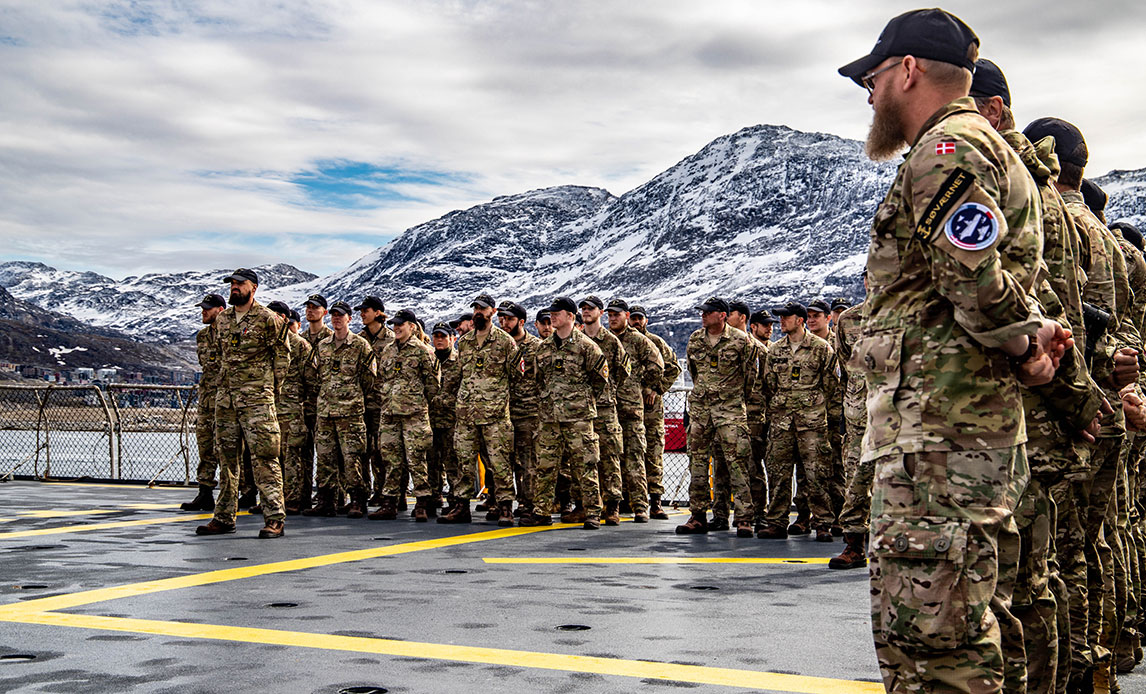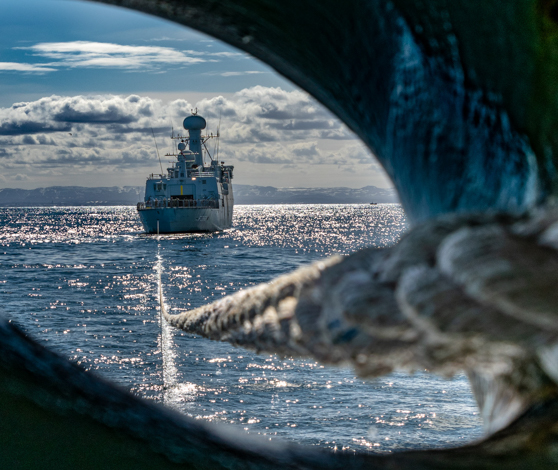Greenland’s first security strategy looks west as the Arctic heats up

Facing an unpredictable Russia, Greenland wants stronger relations with the US and Canada and a new high-level Arctic North American Forum for the leaders of all indigenous territories.
The government of Greenland — known as Naalakkersuisut — is proposing the creation of an Arctic North American Forum to strengthen ties with indigenous leadership and elected assemblies in Nunavut, Nunavik, the Northwest Territories and Yukon in Canada and their counterparts in Alaska.
Greenland’s first-ever foreign policy, defense and security strategy was published on February 21. In its foreword, Greenland’s foreign minister Vivian Motzfeldt writes that the government in Nuuk sees room for a forum where government decision-makers and parliamentarians in Alaska, Arctic Canada and Greenland can meet to share their experiences, learn from each other and initiate concrete collaborations.

The document ‘Greenland in the World – Nothing about us without us’ outlines a security strategy for Greenland that emphasizes strengthening cooperation with its North American partners.
“Despite our differences, the diverse North American regions face many of the same challenges and opportunities that we do. We are all located in the Arctic region, with largely similar climates and coastlines along the Arctic Ocean,” the text reads.
Naallakkersuisut claims that indigenous leaders across North America would benefit from increased cooperation in such diverse fields as the social and health sectors, education, climate change adaptation, the development of mineral resources, mobility of mine workers, renewable energy, tourism and the arts.
Human rights and Russia sanctions
The 27-page strategy, hints at the country’s concerns about a potential arms race with Russia in the Arctic, brought about by Russia’s invasion of Ukraine and its continued military build up in the Arctic.
Greenland’s new strategy underscores Naalakkersuisut’s commitment to international human rights conventions and Greenland’s long-standing commitment to western and pan-Arctic alliances and institutions such as NATO, the EU, the Arctic Council, the Inuit Circumpolar Council and the Nordic Council.
Greenland seeks to open a representative office with the UN in New York, place an official with the UN in Geneva and expand relations with Canada through the opening of a representative office in Ottawa. A similar office in Washington was opened in 2014.
Greenland also subscribes to current western sanctions against Russia and acknowledges that the Arctic security landscape is changing as a result of Russia’s invasion of Ukraine.

“Decisions on security and defense policy must be made — also in Greenland and in the Arctic whether we like it or not. We must contribute to these discussions and decisions in a qualified way,” the strategy states.
It does not mention Russia directly, but highlights how Greenland is threatened by “covert operations that strike civilian infrastructure and communications with no respect for international law, even in our part of the world”.
“Greenland is also subject to malicious cyber attacks, and we consequently need to do more to protect our critical infrastructure and strengthen our capacity in this area,” the strategy reads.
A Peace Center in Nuuk
Naalakkersuisut stresses Greenland’s commitment to continued security cooperation with the US, which runs Pituffik Space Base, a military base in North Greenland. A sophisticated radar at the base is part of an early warning system designed to protect the US against missile attacks, not least from the Russian Arctic. The document states that the US remains one of Greenland’s closest allies. Denmark’s Arctic Command, headquartered in Nuuk, still protects Greenland’s borders, but Naalakkersuisut is aware that Denmark’s military powers are limited.
:quality(70)/cloudfront-us-east-1.images.arcpublishing.com/archetype/JMRZE3KNLZBKRE6J67RHG4YUXM.jpg)
“Under the Defense Agreement of 1951, the United States is effectively the defender of Greenland in the event of a military conflict. Furthermore, Pituffik Space Base constitutes a key component of US national security. Greenland intends to continue its productive dialogue with the United States on defense issues, bearing in mind that we play a key role in the defense of the United States against external threats, especially from the Arctic region,” the strategy reads.
Uffe Østergaard, professor emeritus of European history at Copenhagen Business School, finds that the strategy broadly aligns Greenland’s position with that of the broader Kingdom of Denmark, to which Greenland belongs, but he finds the new approach to the US somewhat limited.

“Greenland appears happy about the US interest in Greenland, but the strategy contains very little analysis of this interest. It mentions Pituffik Space Base, but there is nothing about US interests in Greenland’s minerals, the new Arctic shipping routes or other of Greenland’s important resources,” he told Arctic Today.
A region of peace
In the new strategy Naalakkersuisut stresses Greenland’s long-standing position that the Arctic should remain a low-tension region. It has long been the view in Nuuk that an arms race and increased military presence in the Arctic will not benefit indigenous communities.

“We cannot be naïve. But we must never waiver when it comes to peace. We need to observe and study how peace is maintained and achieved elsewhere in the world. Unlike many other regions of the world, the Arctic has not witnessed the destructive power of countless wars,” the strategy says.
To that end, Greenland will establish a Peace Center in Greenland, hopefully in collaboration with external contributors, with a focus on peace in the Arctic.
Greenland’s government also spells out its position that no non-Arctic states should aim for increased permanent military presence in the Arctic, an argument that seems to relate to current debates about NATO’s future plans in the region. At their summit last July, the NATO governments agreed that NATO should design its first regional plan for the North Atlantic and the Arctic.
“We are opposed to non-Arctic countries expanding their permanent military capabilities in the region, thereby contributing to a militarization of the Arctic. This must be avoided. Greenland also encourages all Arctic States to exercise restraint with regard to any military build-up,” the strategy says.
While Naalakkersuisut has signalled that it opposes a stronger military presence in the region, it has acknowledged the need for increased monitoring of military activity in and around Greenland and in the Arctic as a whole.
Special mention is made of the so-called GIUK straits between Greenland, Iceland and the UK, where the defense forces of the US, Norway, Denmark, the UK and others are already on frequent alert for Russian military submarines and other vessels.
“With increased participation, Greenland will also be able to contribute to monitoring the
seas between Greenland, Iceland and the United Kingdom, a naval choke point commonly referred to as the GIUK gap. At the same time, we will strive to maintain low tension in the region,” the strategy says.

Cooperation with China?
The new strategy also addresses the thorny issue of Greenland’s relations with China.
Denmark and the US harbor serious concerns that China may gain significant influence in Greenland, which has a population of just 56,000.
China is already one of the biggest markets for fish and shrimps produced in Greenland and in 2023 Greenland opened a representative office in Beijing. Private Chinese firms have shown significant interests in Greenland’s rich mineral resources, including some of the world’s largest deposits of rare earth minerals, and in 2018, one of China’s largest construction companies, China Communications Construction Company Ltd, was invited by Nuuk to enter a bid for the construction of two large airports in Greenland—a prospect that the Danish government put a stop to.
In Greenland’s new foreign policy strategy, Naalakkersuisut reiterates its position that Greenland is free to trade with any partner.
“We intend to attract investments in suitable sectors from like-minded countries that share our values. However, Greenland will not exclude cooperation with countries that accept and respect our values and legislation. Work has begun on drafting an investment screening law,” the strategy goes.
Elsewhere in the document, however, Naalakkersusiut promises to establish by law a new screening process for foreign investments in Greenland. It also says that new security considerations will be taken into the equation when considering foreign investments from debatable origins—read China—should become relevant again.
More trade with the US and Canada
China and other Asian economies remain prime targets for Greenland’s exports of seafood, but in its new strategy Naalakkersuisut places an even stronger emphasis on increased trade with the US and Canada.
“We must work to strengthen supply chain security in an unstable world and explore ways to expand trade with our large North American neighbors. Today, there are trade barriers that severely impede the free ex- change of goods and services, and can only be removed through political solutions,” the strategy goes.
“For many years, Greenland has not engaged in much trade with our close neighbors to the west and southwest. We need to change that, which is why we are focusing on markets in North America, for both imports and export,” the text says.
Deliberations in Greenland about the new strategy have delayed for two years a broader Arctic Strategy for the Kingdom of Denmark, to which Greenland belongs. The Kingdom’s Arctic Strategy expired in 2021, and Denmark is presently the only Arctic country without an active Arctic strategy.
Denmark holds sovereignty over Greenland and the semi-autonomous government in Nuuk has no formal influence on the Kingdom’s defense and security policies. In the last couple of years, however, Greenland’s political leaders have been much more closely involved in negotiations with Denmark about the Kingdom’s defense and security in the Arctic.
You can read more on Greenland’s security strategy on the Arctic Institute’s website.
Greenland’s new strategy for foreign affairs, defense and security was published Wednesday 21 January in Greenlandic and Danish.
Danish journalist and author Martin Breum is based in Copenhagen. He is a regular contributor to ArcticToday.